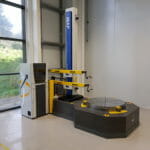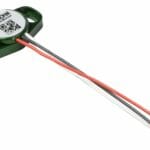Like many manufacturing processes, injection moulding (IM) can benefit considerably from automation. While the move towards offshoring work in the early 2000s impacted its adoption across Europe, Sumitomo (SHI) Demag is reporting a change in attitude and reversal in this trend, with a growing number of plastics processors embracing robotics to stay ahead of their competition.
No longer the preserve of a few operators with specialist needs, statistics released by the European plastics machinery organisation EUROMAP shows that the number of IM machines sold equipped with robots rose from 18% in 2010 to almost a third (32%) in the last quarter of 2018. Additionally, with Euromap’s unveiling in 2018 of the first digital Industry 4:0 Standard, automation looks set to become more commonplace in plastic processing facilities in the future.
Nigel Flowers, Managing Director at Sumitomo (SHI) Demag comments: “There has been a significant upwards trend towards automation in plastics processing. Part of this has been driven by demand for more flexible solutions, so the use of 6-axis industrial robots in precision moulding especially is certainly more commonplace today. Additionally, the price gap between Cartesian and industrial robots has closed markedly, while at the same time, they’ve become easier to programme and simpler to integrate.”
Nigel adds: “In terms of robotic configurations, there is certainly plenty of choice. If all the robot is doing is moving a part from the moulding machine, a 3-axis robot should be sufficient. However, a 5 or 6-axis robot can perform more complex manipulation tasks. Precision components, such as electronic parts or hearing aids, are typically getting smaller and smaller. When you are handling or trying to remove parts from a mould that measure just millimetres, a dexterous robot is very important.”
In 2009, the Sepro Group, in partnership with Sumitomo (SHI) Demag, developed a special range of robots adapted to the company’s popular Systec and IntElect systems. Both systems are widely used in electronics, automotive, medical and packaging moulding.
Noting the benefits of integrating robotics into precision injection moulding systems, Nigel says: “In precision moulding applications, robots are usually chosen for their range of operation, accuracy, repeatability and cleanliness. Sometimes the customer needs to transfer parts, insert load, apply labels or remove complex parts in non-linear movements. For packaging, robotics is primarily used to make customer applications run faster and more cost-effectively. With take-out times of 0.5 seconds or less, it can sometimes be faster to use a robot to remove parts than to let them fall under gravity.”
Automation in action
The simplest robot applications involve sequencing with the moulding cycle to remove finished parts from the machine and placing them on a table. Another common task involves stripping sprues and waste from around the mould and placing them in a granulator for recycling.
In-mould labelling (IML) is another prime area for automation, and in recent years European adoption in packaging applications has really taken off. Speed is all-important in this role, and Sepro offers a series of high-speed side-entry robots, incorporating label dispensing and placing technology.
In-mould insertion is also common practice when creating automotive parts. In particular fabric insertion, which is a major feature of many IM installations. Other examples in motor industry applications involve the exposure of moulded bumpers to a gas flame in preparation for downstream spraying.
Vision can be added to IM robotics to monitor quality and create a traceability record. Sumitomo (SHI) Demag continues to invest a lot of R&D into this area. For example, the company has previously built a cell whereby the master computer connects to the robot, a tiny camera inside the cavity of water flow tubes being moulded, and the laser marking station. These images are then cross referenced with ‘pass/fail’ shots held in the system and if the part passes the quality checks it is moved to the labelling station by the robot. A unique part code label is printed and adhered to the side of each moulded flow tube. The two images taken by the camera and corresponding part ID code is then stored by the system before the robot lays the finished product into a blister tray.
Most recently, the company, in partnership with KURZ, created an automated cell to create a super-sleek, sensory door trim with a high gloss day night design. Featuring a 6 axis robot with gripper, this innovative automotive cell incorporates an advanced In Mould Decorating (IMD) feature whereby foil is added to the door trim panel during the bonding process to provide touch functionality. Process data is then integrated into the higher-level manufacturing executive system (MES) to generate the unique data matrix sensor, which is bonded to the part to give each individual part its traceability data.
Other elements of this automated cell include a cutting station for sprue removal, a UV curing station to give the car trim its high gloss, a cleaning station for automated polishing, and a visual inspection chamber.
For hygiene sensitive markets, such as medical and healthcare, it is possible to attach a robot to the frame of the IM machine, enabling manufacturers to automate functions like handling and packing within a compact and enclosed cleanroom-standard cell. “Once you have the filter and laminar airflow, the robot is sitting in a cell that’s cleaner than the average operating theatre!” exclaims Nigel.
Faster Return on Investment
Speed, yield, repeatability, reliability, multi-tasking and long-term cost saving are all reasons why end users might opt for a robotic injection moulding solution. Many plastic processors are finding the capital cost of robot-equipped IM machinery more affordable, which is helping to justify the return on investment (ROI).
“Being able to operate around the clock inevitably increases productivity and consequently profitability,” says Nigel. “Also, there is greater awareness that with today’s industrial robots, a processor won’t just be specifying for a single application. A robot today can be reprogrammed to support a different product. Some customers are beginning to switch from Cartesian robots to industrial 6-axis systems, which evidence suggests is connected in part to future-proofing investments.”
For many, the strongest associations when it comes to sophisticated robotics are with large and already highly-automated operations, such as automotive plants. In fact, robotic development is just as rife among smaller-scale manufacturers.
“Even packaging converters with just three or four IM machines are seeing the benefits of being able to extend their working hours,” says Nigel. “If they want to move to longer shifts, they may be looking at the simplest solutions such as Cartesian robots.” As those companies grow, plan for the longer-term and put more emphasis on in-built flexibility, there is always the option of moving to a 6-axis alternative.
Addressing changing workforce needs
For small to medium sized plastics processors in Europe, the shortage of skilled labour remains a key issue that can hinder innovation. However, proximity of a plastics manufacturer to domestic customers is a key advantage. With labour costs rising, robots can help local plastic processors to maintain consistent performance and consistent quality.
Nigel explains: “With industrial automation, one operator can look after, say, 10 machines. You can achieve more consistent output while reducing manufacturing costs.”
Rather than being a jobs taker, there’s also strong evidence to suggest that adoption of robotics create more interesting and varied jobs. This is driving the need for more advanced engineering skills.
There’s little doubt that in terms of flexibility and dexterity, integrating robotics and automation into IM set-ups can increase manufacturing competitiveness. Nigel ends: “As we enter the era of Industry 4:0 there is a definite shift towards integrated production cells, with a need for robotics and peripheral equipment to work seamlessly together.”





